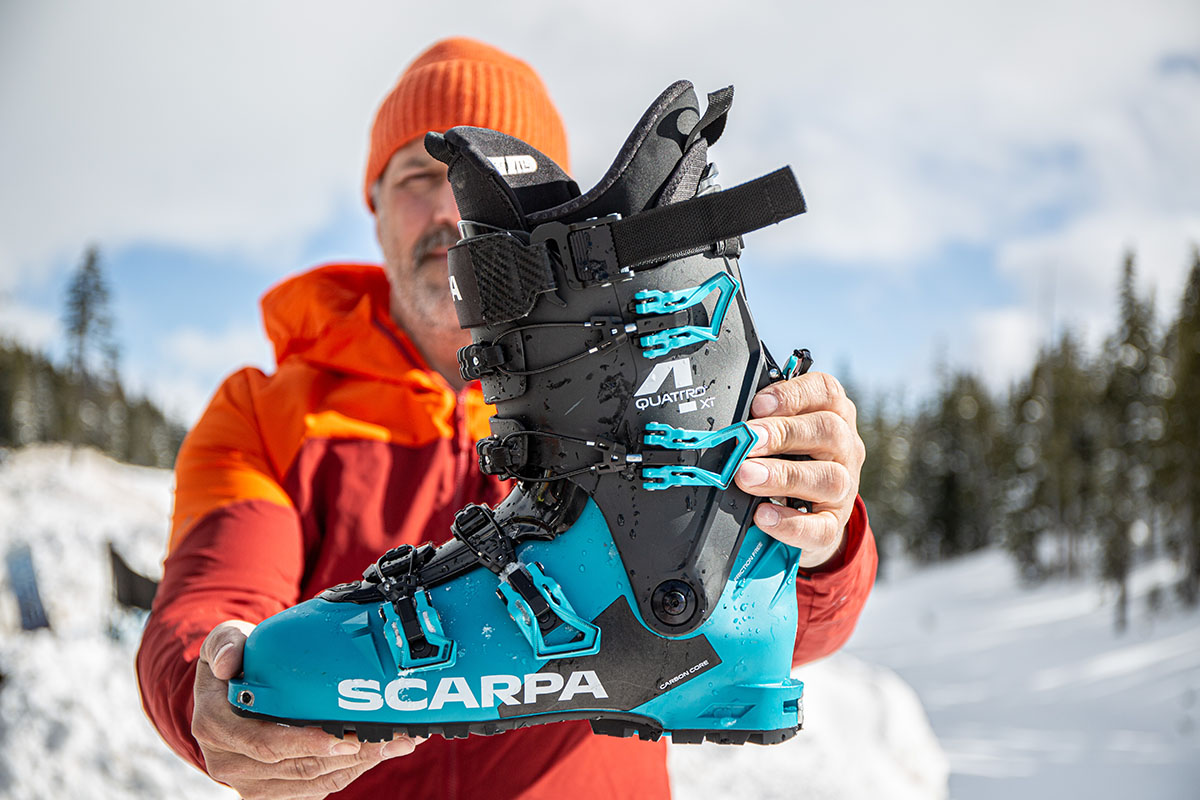

Price: $869
Weight per pair: 7 lb. 4.4 oz. (size 28.5)
Flex: 130
What we like: A remarkable downhill companion that doesn’t compromise much on the uphill.
What we don’t: Fits narrower than its 100mm last suggests; GripWalk sole is not replaceable.
See the Men's Scarpa 4-Quattro XT See the Women's Scarpa 4-Quattro XT
Scarpa is an irrefutable leader in the backcountry ski boot market, and they recently made a push into the freeride space with the 4-Quattro XT. We put the boot through a mix of backcountry and resort riding last winter and came away largely impressed. In addition to its clear downhill prowess, the 4-Quattro exceeded expectations on climbs with generous range of motion, a grippy outsole, and good adjustability—all while undercutting most crossover competitors in weight. It’s a steep investment at $869 and fits on the narrower end (a bit of a surprise given the 100mm last) but leaves little to be desired in terms of all-around performance. Below we outline our experiences with the 4-Quattro XT. To see how it stacks up to the competition, see our article on the best backcountry ski boots.
The Scarpa 4-Quattro XT looks and feels like a typical downhill-focused boot, so I was pleasantly surprised to learn that it’s a great uphill partner, too. In terms of mobility, the 4-Quattro has a total flex (forward and backward) of 61 degrees, which is very generous and provides ample range of motion for ascending. It also avoids the definitive stopping point that I’ve experienced with some other designs that boast an overlapping cuff and shell, including the since-discontinued Maestrale XT. For reference, I’ve only had to revert to using the heel risers on my G3 Ion or ATK Freeraider bindings a few times on particularly steep slopes. Further, the 4-Quattro’s rear flex exceeds my foot’s range of motion and makes it easy to navigate tight, techy switchbacks that require awkward kick turns. Bootpacking performance is similarly competitive: The GripWalk-compatible Presa outsole bites well into everything from hardpack snow to ice and rock, and it’s compatible with most automatic or semi-automatic crampons.

To maximize climbing comfort, I release the top and bottom buckles and loosen the power strap while leaving the buckle at the lower cuff snugly in place. This allows my calf and ankle to flex naturally without my heel moving around sloppily inside the boots. In this configuration, the 4-Quattro felt a lot like Scarpa’s more uphill-focused Maestrale RS while meandering through the Mount Washington forest and ascending the steep, relentless skin tracks in the Mount Baker backcountry, which is very high praise. To be clear, the 4-Quattro is still a crossover design and will be too heavy for speed-focused adventures and/or big and ambitious days out. But I’ve been highly impressed by the boot’s climbing abilities and consider it one of the most balanced downhill-oriented designs I’ve tested to date (beating out the likes of Rossignol's Alltrack Elite and Lange's XT3 Free).

Put simply, the Scarpa 4-Quattro XT shines when pointed downhill. Despite its great touring abilities, the boot was specifically built to excel on the descent whether you’re lapping frontside groomers or hitting steep lines in the backcountry. My first test of the boots’ downhill capabilities took place at my local ski hill, Vancouver Island’s Mount Washington Alpine Resort, and that prowess was immediately clear: The carbon-infused Grilamid lower shell and large, overlapping cuff provide great torsional rigidity, while the fairly progressive 130 flex allows the boot to drive and transfer energy extremely well. The four-buckle layout is another boon for power transmission—it feels much more like a traditional alpine boot than a compromised backcountry design—and promotes a locked-in and very secure feel. All told, the 4-Quattro XT offers a remarkably powerful ride and has inspired confidence in conditions ranging from wet and heavy snow to icy hardpack.
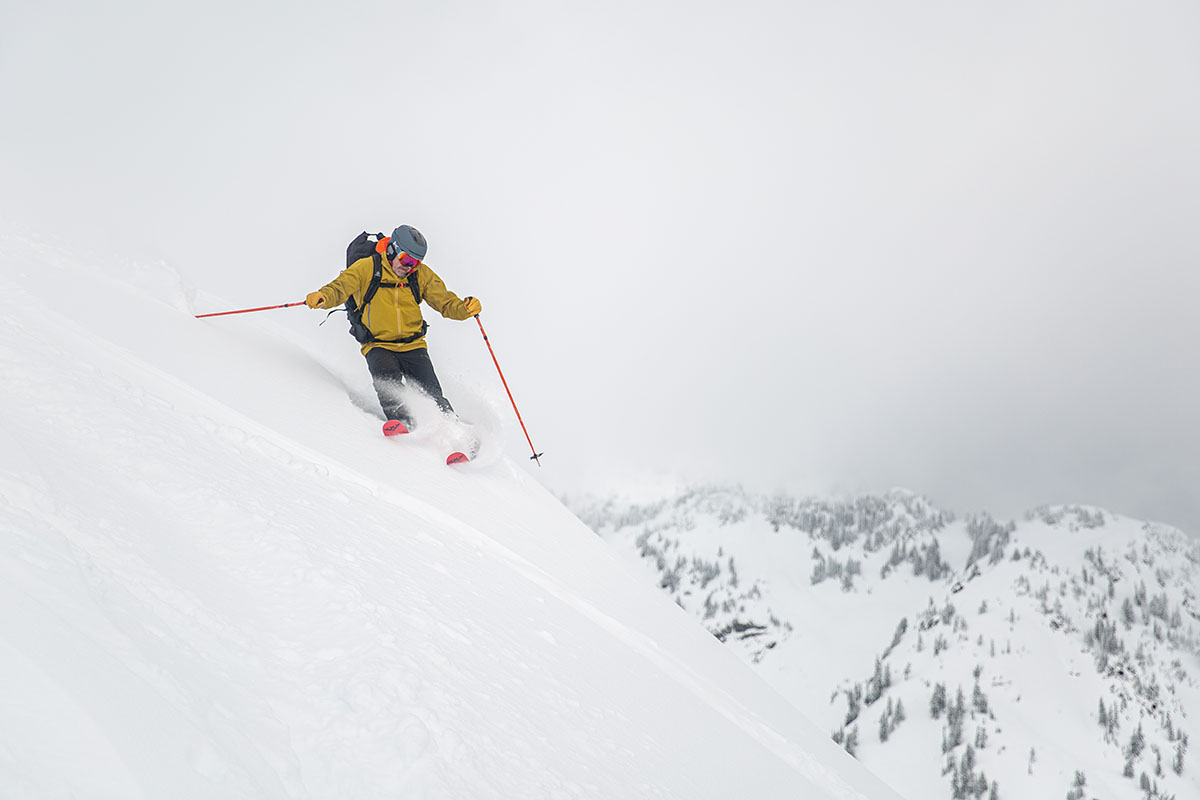
Like the Maestrale RS, the 4-Quattro XT is both AT and TLT binding-compatible, and I’ve been using the boot with the G3 Ion 12, Salomon S/Lab Shift 13, and ATK Freeraider 14 bindings on skis ranging from 107 to 118 millimeters in width (the Black Crows Corvus, Ferox, and Camox Freebird). Regardless of which setup I chose, the 4-Quattro XT felt like a true alpine boot when locked down: The four-buckle design provides a noticeably secure and stable feel, and the stretchy power strap allows me to really lean into the boots and drive hard. Along with the overlapping cuff, it also helps promote a smooth ride when making tight turns and navigating through the trees. Taken together, the 4-Quattro XT lives up to its billing as a supremely fun and skillful freeride companion.
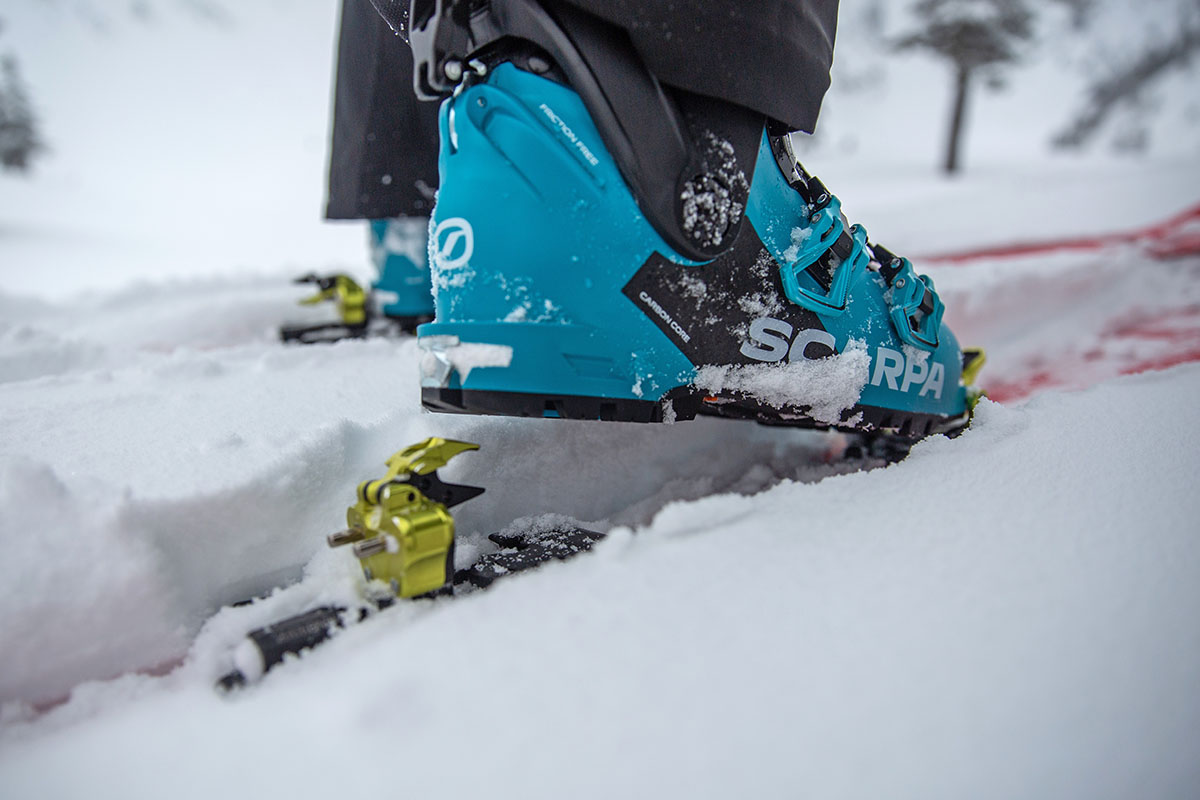
The 4-Quattro XT clocked in at 7 pounds 4.4 ounces on my scale for the pair in a size 28.5 (listed weight is 6 lb. 9.8 oz. for a pair of size 27s), which is competitively light for a design with such downhill prowess. For comparison, it considerably undercuts most similarly intentioned crossover designs like the Atomic Hawx Ultra XTD 130 GW (8 lb. 0.8 oz.), Tecnica Cochise 130 DYN GW (8 lb. 2.5 oz.), and Lange XT3 Free 130 MV GW (7 lb. 14.3 oz.) while checking in a little heavier than more uphill-oriented all-rounders like Scarpa’s Maestrale RS (6 lb. 6.7 oz.) and Dynafit’s Radical Pro (6 lb. 2.8 oz.).

Like the Maestrale RS, Scarpa’s 4-Quattro XT incorporates a couple key weight-saving measures, including a carbon fiber-infused Grilamid shell and streamlined buckle design (more on the latter below). For reference, I’ve comfortably toured in the boots for hours on end without giving them a second thought. In my opinion, the 4-Quattro strikes a real Goldilocks balance for me: light enough that I don’t think about it on the uphill and powerful enough to tackle any line down the mountain.
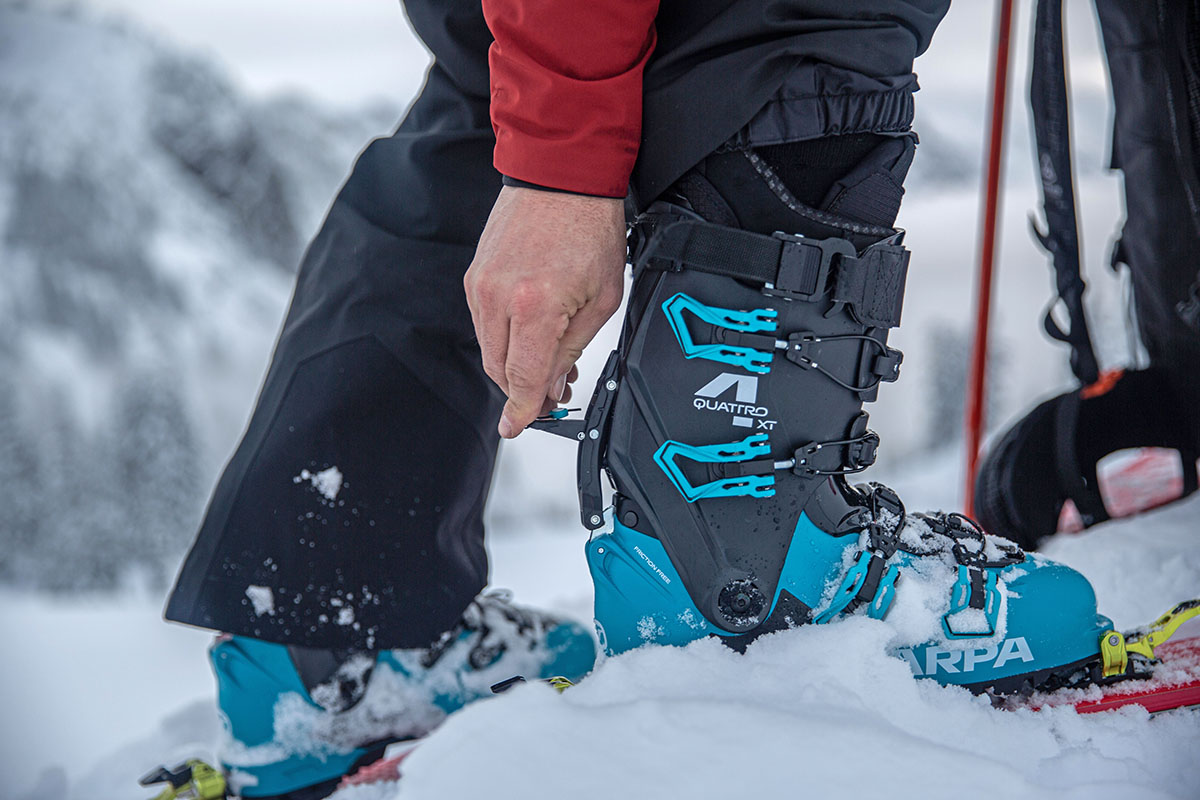
Like most traditional downhill boots, the 4-Quattro XT features a four-buckle layout—two on the cuff and two on the lower shell—with a power strap at the top. The buckles are micro-adjustable for dialing in tightness around the entire foot, and all four employ a flexible steel cable (rather than a rigid metal loop) that makes buckling things down easy even if the two ends aren’t lined up perfectly. All in all, I’ve found the system to be incredibly effective at promoting a snug, locked-in feel—those coming from standard alpine boots shouldn’t notice a difference in support or ease of use. To really fine-tune things, you can also adjust the length of the buckles by twisting the attachment loops, and the receiving hooks on the cuff can be moved horizontally with a simple screwdriver adjustment.

As I touched on above, the power strap is equally well executed and makes it very easy to adjust tightness around the cuff. There’s a bit of stretch to the fabric to really snug things down, and the elasticity also contributes to the boot’s progressive flex and overall comfort. Another thoughtful touch is the hook-based tensioning system, which allows you to loosen the strap for skiing by disengaging the cam without undoing it completely. This helps make the transitioning process quicker and easier and is much more effective than standard Velcro designs, in my opinion. It also helps if you happen to overtighten the strap, which is easy to do given the stretchiness in the fabric. I still have to undo the hook when taking the boots off to create enough room to get my feet out, but it’s nevertheless a reliable and very convenient system. Finally, Scarpa included a Recco reflector hidden in the strap to help rescuers find you in the event of a backcountry emergency.

Scarpa recently revamped their Speed Lock ski/walk mechanism, and I’ve been very pleased with the latest “4” found on the 4-Quattro boots. For reference, the Speed Lock lever on my past-generation Maestrale RS boots was prone to icing up and required frequent cleaning to effectively lock the boot into ski mode (I outline this in more detail in my in-depth Maestrale RS review). However, the 4-Quattro’s lever is depressed farther into the spine and therefore less exposed to the elements, which has eliminated the security issues. The new design also boasts a sizable spring that applies solid pressure to the lever, ensuring that it properly engages in both ski and walk modes. Importantly, the exposed spring hasn’t ever iced up, and the lever has stayed securely in place throughout testing. Finally, I appreciate that Scarpa included a small pull cord that makes it easier to operate when wearing gloves.
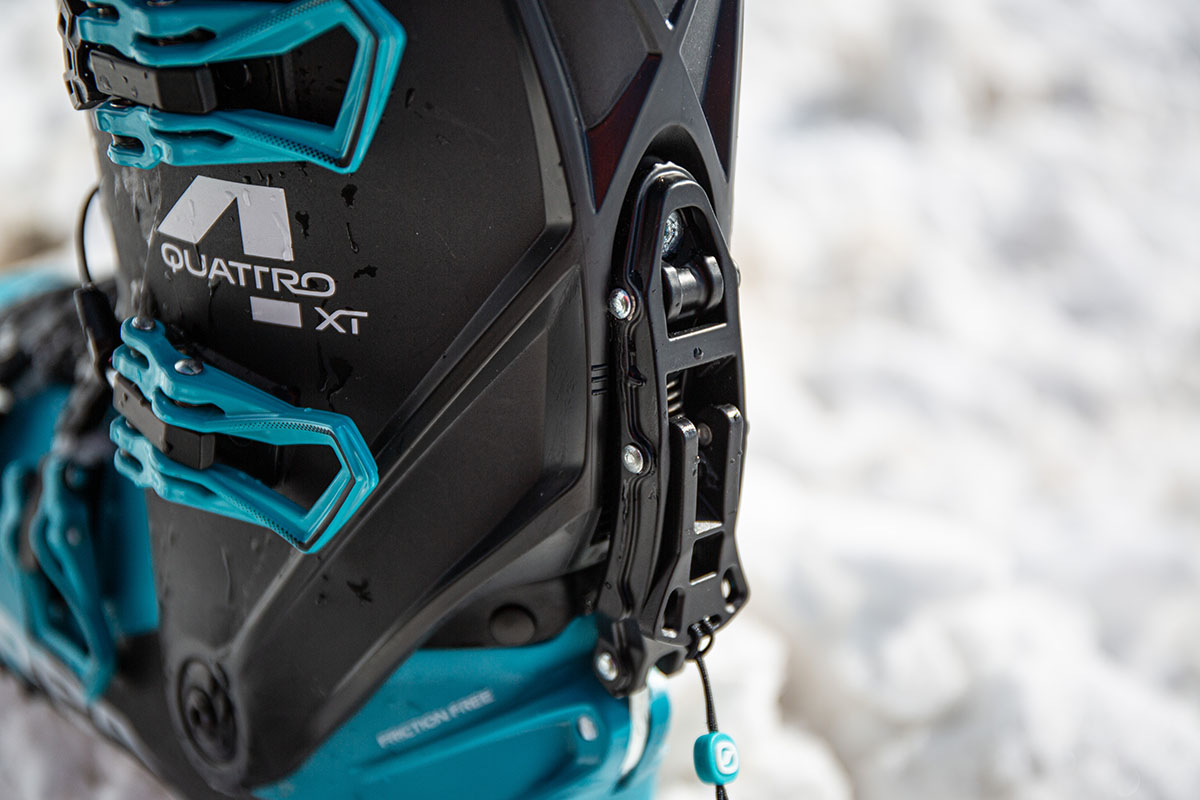
I’m a huge fan of Intuition liners and was very happy with the 4-Quattro’s 4Pro Flex XT iteration. Overall, it was comfortable out of the box and conformed nicely to my feet after a very short break-in period (note: Those who want to expedite the process can have the liner heat-molded by a bootfitter). Additionally, the foam padding was effective at keeping my feet protected without creating too much bulk inside the boots, and I found the balance between breathability and warmth to be spot-on. For reference, I’ve suffered nerve damage in the past from cold exposure, but the 4-Quattro’s liner kept my feet toasty even when I submerged the boots in wet snow for hours on end without causing me to overheat in milder conditions. And a final—albeit small—detail: The tongue and cuff loops connected to the liner are generously sized, which makes them easy to grab when wearing bulky ski gloves or mittens.

As we’ve come to expect from Scarpa, everything about the 4-Quattro XT exudes quality, from the carbon fiber-infused shell to the sleek but functional ski/walk lever. And importantly, the boots have held up very well to testing. There are some light scratches and scrapes along the cuff and lower shell, as well as around the tech pin inserts, but it’s all purely cosmetic and to be expected with regular use. The rest of the design looks and feels like new: The Intuition liner is supple and hasn’t packed out (other than conforming to my feet as intended), all the smaller components—including the steel-wired buckles and stretchy power strap—are intact and working flawlessly, and the GripWalk soles show no signs of deterioration. Our only construction-related complaint is that the sole is permanently fixed, meaning it can’t be replaced (especially applicable for guides, patrollers, and others who put a lot of mileage on their soles). But from a durability standpoint, the 4-Quattro is another winner from the Italian brand.

I went with my usual size 28 (314mm BSL) in the Scarpa 4-Quattro XT and found it to be prohibitively short and narrow. To be fair, I do have fairly high-volume feet, but the boots’ 100-millimeter last felt notably snugger than the 101-millimeter last you get with the brand’s Maestrale models, including both the RS and since-discontinued XT. A friend had a similar experience ordering his standard size, which is enough for me to generalize that most folks will likely want to size up. In my case, going up to a 28.5 (316mm BSL) was the right choice: There’s a little extra room in the toe box that’s been helpful for avoiding toe bang while skiing and descending, and I’ve experienced no rubbing or hot spots despite not having the boots punched (something I’ve had to do with both of my Maestrales).

In general, I’d say the 4-Quattro XT fits more like an old-school alpine boot (read: very snug) than a modern backcountry design. For those who prioritize comfort over performance, I recommend considering heat molding to get a more accommodating all-around fit. A final complaint is that the overlapping cuff can make getting in and out of the boots a little tough—the two pieces are quite stiff and tend to dig into my foot as I try to pry it out. If you experience similar issues, warming the boots up in your vehicle before putting them on or taking them off will help loosen things up.

The outdoor industry has seen a sizable uptick in the use of sustainable materials over the past several years, and the changes have recently started trickling down into the ski boot space. In this case, the 4-Quattro XT uses plant-based materials derived from castor oil for the Grilamid shell and cuff (dubbed “Grilamid Bio”) to reduce CO2 emissions. All told, it’s a nice reflection of Scarpa’s ongoing sustainability efforts, and we’re excited to see other ski boot manufacturers follow suit by utilizing more environmentally friendly materials.

I tested the men’s 4-Quattro XT for this review, and it’s also available in a women’s model for the same price. In parsing out the differences, the women’s 4-Quattro XT checks in lighter at 5 pounds 14.9 ounces for the pair (in a size 25), has a wider cuff to accommodate bigger calves, and is sold in a slightly different colorway. The collection also includes 4-Quattro SL (short for “superlight”) models for men and women, which cost $100 less and use a carbon-infused Pebax (rather than Grilamid) shell. Comparing the men’s models, the SL shaves off around 5 ounces per pair and has a softer 120 flex rating but shares most other features outlined above.
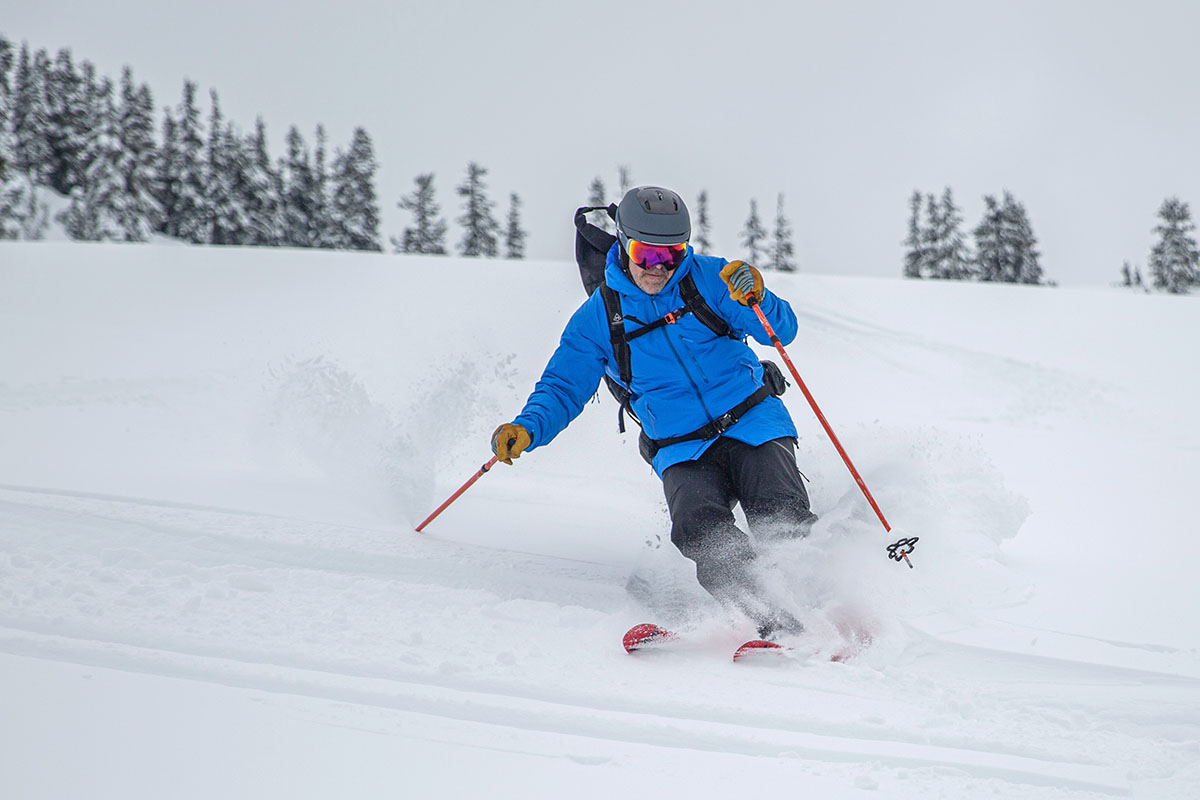
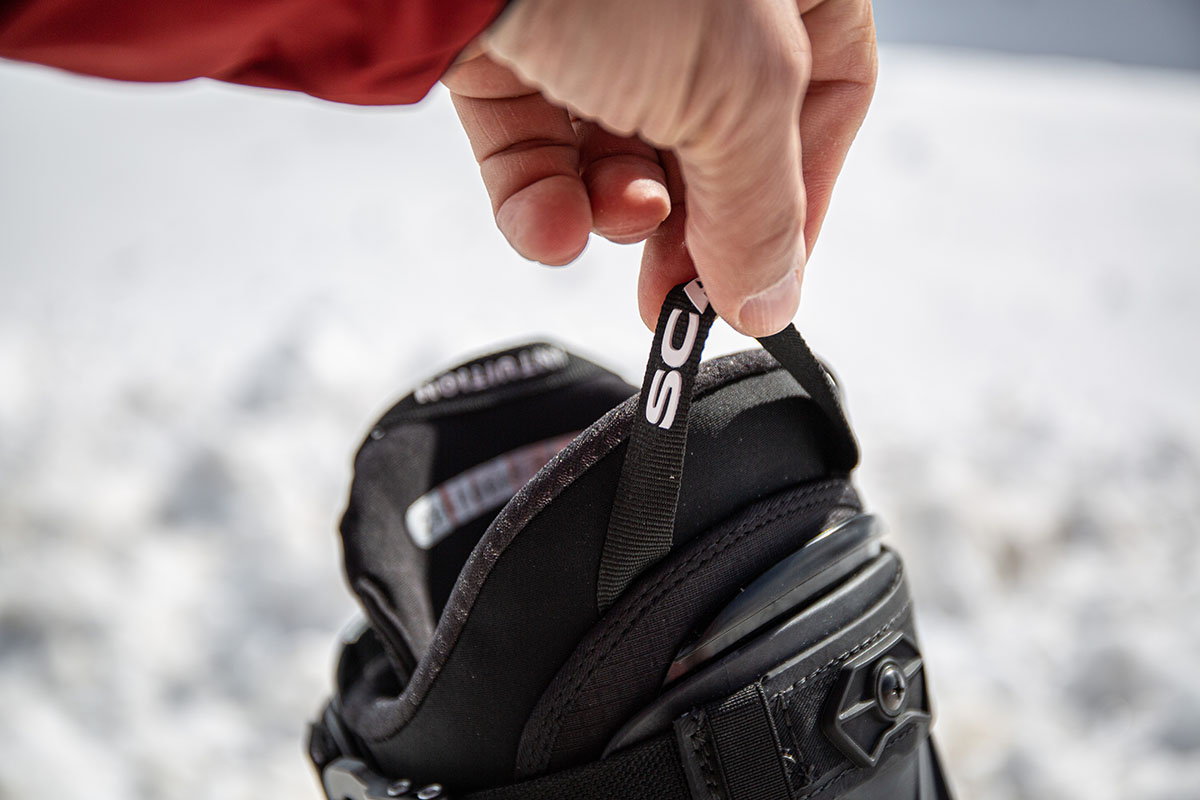
| Boot | Price | Weight | Last | Flex | Motion | Shell |
|---|---|---|---|---|---|---|
| Scarpa 4-Quattro XT | $869 | 6 lb. 9.8 oz. | 100mm | 130 | 61° | Grilamid, carbon |
| Atomic Hawx Ultra XTD 130 | $900 | 8 lb. 0.8 oz. | 98mm | 130 | 54° | Polyurethane |
| Lange XT3 Free 130 MV GW | $850 | 7 lb. 14.3 oz. | 100mm | 130 | 53° | Polyurethane |
| Dynafit Tigard 130 | $900 | 7 lb. | 101mm | 130 | 70° | Grilamid |
| Scarpa Maestrale RS | $949 | 6 lb. 7.7 oz. | 101mm | 125 | 61° | Grilamid, carbon |
The 4-Quattro XT offers an impressive balance between up- and downhill performance, but the modern market is flush with options, and Atomic’s Hawx Ultra XTD 130 is another standout all-rounder. Like the Scarpa, the Hawx flexes freely while hiking —although range of motion is more limited at 54 degrees—but is planted and solid for railing groomers. The Atomic checks in heavier at just over 8 pounds, but it’s still competitively light for a crossover design and gets the slight edge on the descent. Plus, you can replace its GripWalk soles (unlike the Scarpa). On the flip side, we love the Scarpa’s premium Intuition liner and more streamlined ski/walk lever. Fit is the final key difference: The Hawx Ultra has a narrow 98-millimeter last, although Atomic does offer the roomier 100-millimeter Prime XTD 130 for the same price. In the end, both are high-quality boots for those who like to do it all, and a decision will likely come down to how you prioritize climbing versus descending capabilities.
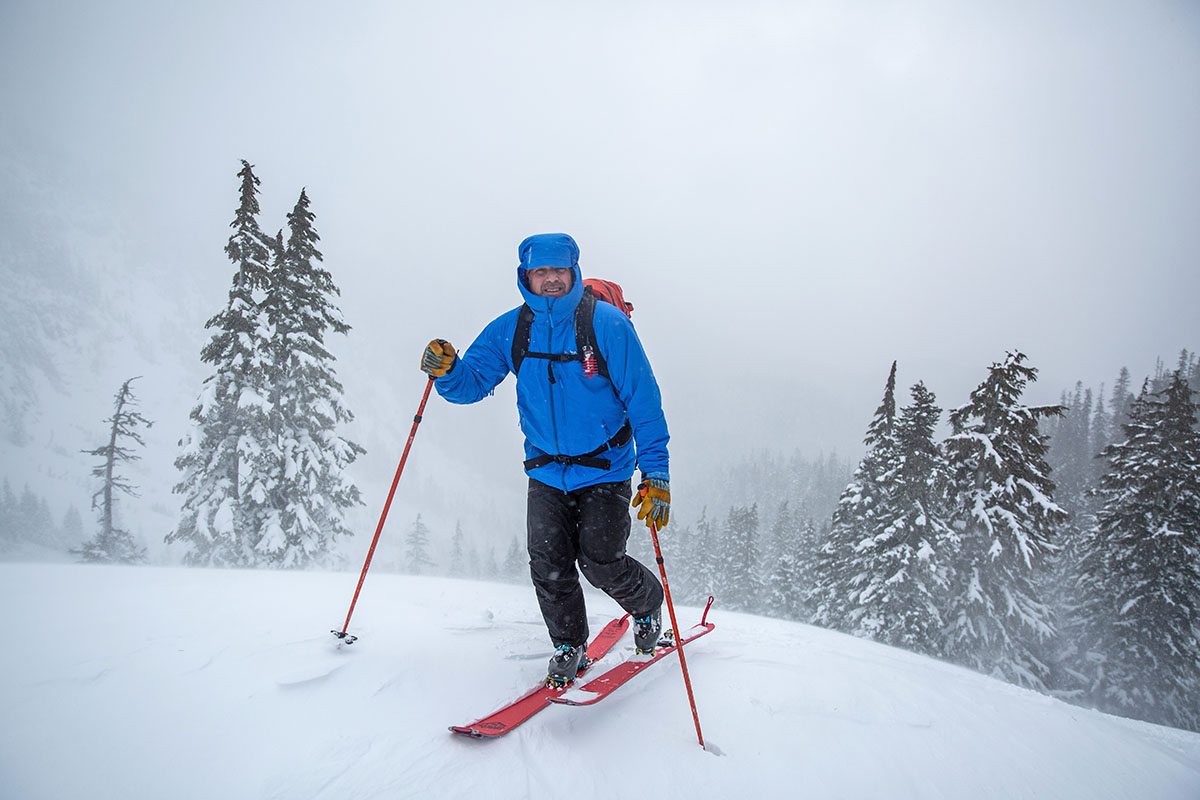
Another favorite among hard-charging backcountry riders is the Lange XT3 Free 130, which we’d categorize as a borderline alpine boot. Like the 4-Quattro, the XT3 Free features a strong 130 flex and secure four-buckle layout that give it an impressively solid and secure feel on the descent. We also appreciate that it’s offered in multiple lasts (97 or 100mm) and flexes, which can’t be said about the 4-Quattro XT. However, the Lange falls noticeably short of the Scarpa on the way up. In addition to offering less range of motion (53 degrees compared to the 4-Quattro’s 61), the XT3 Free is considerably heavier (and feels it), which is a downside for those spending extended time on the skin track. Aggressive riders embarking on the occasional uphill foray likely won’t mind the trade-offs, but we've found that the 4-Quattro is the more well-rounded design.
Next up is Dynafit’s new Tigard 130, which—like the 4-Quattro—offers an impressive balance of freeride performance and touring capabilities. As expected from the uphill specialist, the Tigard boasts a very impressive 70 degrees of cuff rotation, Dynafit’s unique Hoji Lock System for fast and easy transitions, and a reasonable weight of 7 pounds for the pair. The Tigard stacks up well in downhill performance, too, with a stiff 130 flex and sturdy four-buckle layout. And like the Scarpa, the Dynafit doesn’t skimp on premium touches, including a Primaloft-insulated liner, Grilamid shell and cuff (the latter is carbon-infused), and GripWalk-compatible sole. The 4-Quattro is a little cheaper, lighter, and more proven than the new Dynafit, but both designs are remarkably well-balanced options for mixed resort and backcountry use.
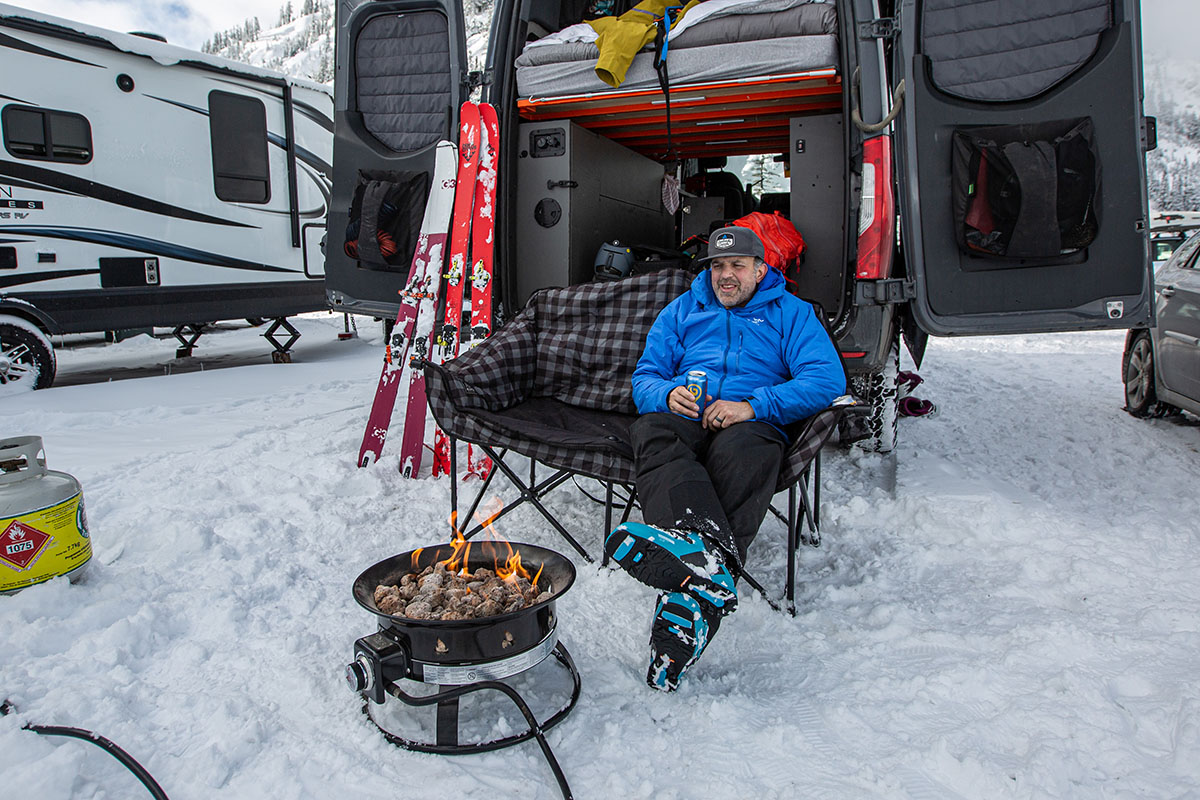
Last but not least is Scarpa’s own Maestrale RS, which tops our backcountry boot round-up this season for its well-rounded touring performance. In parsing out the differences, the Maestrale boasts a more forgiving 125 flex, shaves off a little weight at 6 pounds 7.7 ounces per pair, uses a proven—and similarly capable—Vibram outsole, and boasts a streamlined buckle layout that comprises three buckles (one less than the 4-Quattro) with a cable-based system at the front for locking in the forefoot. Both boots have 61 degrees of cuff rotation, Intuition liners, and Grilamid shells with carbon reinforcements, although the XT’s rides a little higher. A final difference is price: The Maestrale RS retails for $80 more than the 4-Quattro XT. In the end, we'd break it down as follows: For crossover resort/backcountry hard chargers who prioritize downhill performance, go with the 4-Quattro XT; for backcountry riders who prefer to earn their turns and don't necessarily need the added stiffness and power, the Maestrale RS is the better match.